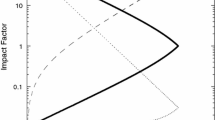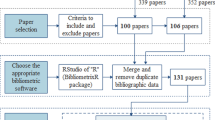Abstract
The “rank distortion” of statistical distribution and its effect on the non-Gaussian nature of scientific activities is discussed. Examples are presented and in particular, the dispersion of publications by journals (the Bradford distribution) is discussed in detail. The data supporting the thesis of non-Gaussian nature of science are reexamined, and the empirical basis of the thesis is extended.
Similar content being viewed by others
Notes and References
S. D. HAITUN, Stationary scientometric distributions. Part 1. The different approximations,Scientometrics, 4 (1982) 5–25; Part II. Non-Gaussian nature of scientific activities. —Scientometrics 4 (1982) 89–104; Part III. The role of the Zipf distribution. —Scientometrics 4 (1982) 181–194.
S. D. HAITUN, op. cit. Note 1 ;
See, for example, A. I. YABLONSKY, Stokhasticheskiye modeli nauchnoi deyatelnosti (Stochastic models of research activities). in:Sistemniye issledovaniya, Yezhegodnik, 1975.System Research, Yearbook, 1975), Nauka, Moscow, 1976, p. 5–42; A. I. YABLONSKY, On fundamental regularities of the distribution of scientific productivity,Scientometrics 2 (1980) 3–34.
This error is made by the present author in Ref. 1, see S. D. HAITUN, op. cit., Note 1.
J. H. WESTBROOK, Identifying significant research,Science, 132 (1960) 1229–1234.
B. HILL, Zipf's law and prior distribution for the composition of a population,J. Am. Stat. Assoc., 65 (1970) 1220–1232.
See S. D. HAITUN, op. cit. note 1, Fig. 2.5.
S. D. HAITUN, op. cit., note 1.
S. C. BRADFORD, Sources of information on specific subjects,Engineering, 26 (1934) January; S. C. Bradford Documentation, London, Grosby Lookwood and Son Ltd, 1948.
F. F. LEIMKUHLER, The Bradford distribution,J. Docum., 23 (1967) 197–207; F. F. LEIMKUHLER, Operational analysis of library systems,Information and Management, 13 (1977) 79–93.
B. C. BROOKES, The derivation and application of the Bradford-Zipf distribution,J. Docum., 24 (1968) 247–265; B. C. BROOKES, Bradford's law and the bibliography of science,Nature, 224 (1969) 953–956; B. C. BROOKES. Theory of the Bradford law,J. Docum., 33 (1977) 180–209.
O. V. GROOS, Bradford's law and the Keenan-Atherton data,Amer. Docum., 19 (1967) 46.
These approximations are presented in: S. D. HAITUN, op. cit., note 1.
W. GOFFMAN, K. S. WARREN, Dispersion of papers among journals based on a mathematical analysis of the diverse medical literatures,Nature, 22 (1969) 1205–1207.
See S. D. HAITUN, op. cit, note 1 182.
S. COLE, J. R. COLE, Visibility and the structural bases of awareness of scientific research,Am. Sociol. Rev., 33 (1968) 397–483; B. V. DEAN, Evaluating Selecting and Controlling R & D Projects,American Management Association, Inc. 1968; N. C. MULLINS, The distribution of social and cultural properties in informal communication network among biological scientists,Am. Sociol. Rev. 33 (1968) 781–797; D. CRANE, Social structure in a group of scientists; A test of the “invisible college” hypothesis,Am. Sociol. Rev., 34 (1969) 335–352; W. GOFFMAN, K. S. WARREN, op. cit., note 17;Dispersion of papers among journals based on a mathematical analysis of the diverse medical literatures,Nature, 22 (1969) 1205–1207; S. CRAWFORD, Informal communication among scientists in sleep research,Am. Soc. Inform. Sci., 22 (1971) 301–310; D. CRANE,Invisible colleges, Chicago-London, 1972; R. K. MERTON,The Sociology of Science. Theoretical and Empirical Investigations, The Univ. Chicago Press, Chicago, 1973;Problemy Deyatelnosti uchenogo i nauchnykh kollektivov (Problems of scientists and scientific organization activities). Iss. 5, Leningrad, Nauka, 1973; Iss. 6, Moscow, Leningrad, Nauka, 1977; Iss. 7, Moscow-Leningrad, Nauka, 1979; S. S. BLUME, R. SINCLAIR, Aspects of the structure of a scientific discipline, in: Social Processes of Scientific Development. R. WHITLEY Ed. Boston-London, 1974, p. 224–241;Sotsiologicheskiye problemy nauki (Sociology of science, Moscow, Nauka, 1974; N. S. ENDLER, J. P. RUSHTON, H. L. ROEDINGER. Productivity and scholary impact (citation) of British, Canadian and U.S. departments of psychology (1975),Am. Psychol, 33 (1978) 1064–1082; R. E. EVENSON, Y. KISLEY.Agricultural research and productivity, New Hawen, Yale University Press, 1975; K. D. KNORR. The nature of scientific consensus and the case of the social sciences, in:Determinants and Controls of Scientific Development, D. Reidel Publ. Co., Dordrecht, Boston, 1975, p. 227–256;Narodnoye Khozyaystvo SSSR v 1975 g. (Economics of the USSR in 1975), Moscow, Statistika, 1976; B. C. FREEMAN, Faculty women in the American university: up the down staircase,Higher Education, 6 (1977) 165–188; H. ZUCKERMAN.Scientific elite: Nobel Laureates in the United States, Free Press, N.Y., 1977; B. LUBIN, R. G. NATHAN, J. D. MATARAZZO. Psychologists in medical education, 1976,Am. Psychol., 33 (1978) 339–343; Sotsialnoye upravleniye v nauke (Social management in science). Moscow ISI AN SSSR, 1978; H. INHABER, M. S. LIPSETT. Gaps in “Gaps in technology” and other innovation inventories,Scientometrics, 1 (1979) 85–98;Scientific Productivity, F. M. ANDREWS Ed., Cambridge Univ. Press, and UNESCO, Cambridge, Paris, 1979;Sociology of Science and Research, J. FARKAS Ed. Budapest Akadémiai Kiadó, 1979; M. P. CARPENTER, F. NARIN. The subject composition of the world's scientific journals,Scientometrics 2 (1980) 53–83; A. HEERINGEN. Dutch research groups, output and collaboration,Scientometrics, 3 (1981) 205–315.
J. S. COLEMAN,Introduction to mathematical sociology, Free Press of Glencoe, N. Y., 1964;Sotsiologiya v SSSR (Sociology in the USSR), v. 1, 2 Moscow, Mysl, 1966; F. EDDING, D. BERSTECHER,International developments of educational expenditure 1950–1965, UNESCO, Paris, 1969; B. HILL, op. cit., note 9; M. G. BULMER, On fitting the Poission longormal distribution to species abundance data,Biometrics, 30 (1974) 101–110; R. MORGAN, E. E. IRONS, E. A. PEREZ, T. N. SOULE, A. K. FRIEDScience and Technology for Development, N. Y., Pergamon Press, 1979.
See S. D. HAITUN, op. cit., note 1, p. 190–191.
See S. D. HAITUN, op. cit., note 1 p. 94.
Author information
Authors and Affiliations
Rights and permissions
About this article
Cite this article
Haitun, S.D. The “rank distortion” effect and non-Gaussian nature of scientific activities. Scientometrics 5, 375–395 (1983). https://doi.org/10.1007/BF02134325
Received:
Issue Date:
DOI: https://doi.org/10.1007/BF02134325




